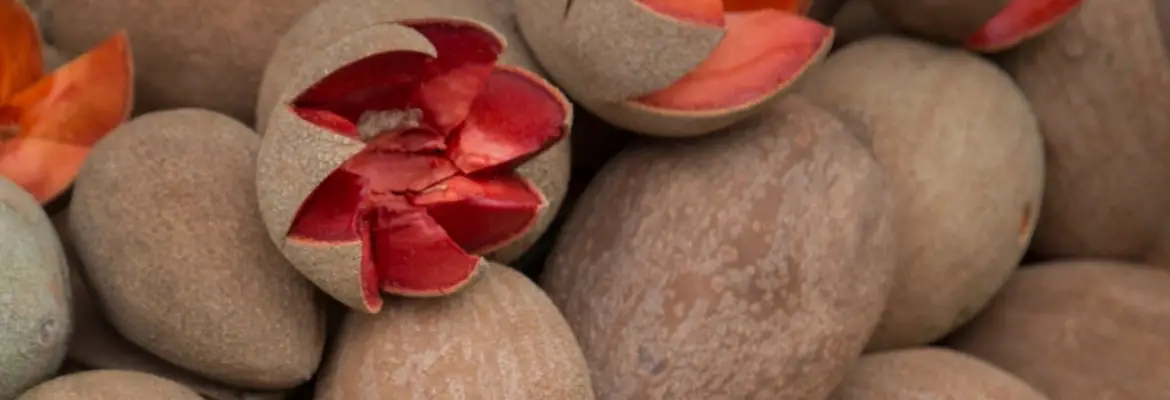Sapote is a tropical / subtropical fruit native to central America but now is being cultivated in may parts of the world such as Asia and Australia. Sapote is technically classified as a berry.
Sapote has sweet custard like tasting flesh which can range from pink to orange in color (vibrant salmon colored).
Sapote can be 4 to 10 inches (10 to 25 cm) in length and 3 to 4.5 inch (8 to 12 cm) in width. Average weight of sapote fruit might range from 150 gram to 300 grams (5.2 ounces to 10.5 Ounces).

Scientific name of Sapote / Mamey
Pouteria Sapota
Other names of Sapote / Mamey
- Zapote
- Mamey
- Red Mamey
- Tzapotl
- Soapapple
- Red Sapote
- Mamey colorado
- Marmalade plum
Calories by source in Sapote / Mamey
- Calories by carbohydrate in Sapote / Mamey = 93%
- Calories by fat in Sapote / Mamey = 3%
- Calories by protein in Sapote / Mamey = 4%
Fats and Fatty Acid profile of Sapote / Mamey
- Polyunsaturated fat (PUFA) in Sapote / Mamey = 26%
- Saturated fat (SFA) in Sapote / Mamey = 46%
- Monounsaturated fat (MUFA) in Sapote / Mamey = 28%
Nutrition facts of Sapote / Mamey
*Serving size = 100 grams = 3.55 Ounces = 1/2 cup
*DV= % Daily Value (%DV indicates how much nutrients contribute to a person’s daily diet from a serving of a food. DV assists you in determining whether or not a serving of food is high or low in a particular nutrient.)
| Nutrient | Amount | Unit | DV |
|---|---|---|---|
| Calories | 124 | KCAL | |
| Fat | 0.46 | GRAM | 1% |
| Protein | 1.45 | GRAM | 3% |
| Carbohydrate | 32.1 | GRAM | 12% |
Detailed vitamin profile of Sapote / Mamey, vitamin A, vitamin B12, vitamin B6, vitamin C, vitamin D, Folate, Niacin, Thiamin, and Riboflavin is shown in the chart.
Detailed mineral profile of Sapote / Mamey, Sodium(Na), Calcium(Ca), Copper(Cu), Iron(Fe), Magnesium(Mg), Selenium(Se), Phosphorus(P), Potassium(K) and Zinc(Zn) is shown the chart.
Check freshness in Sapote / Mamey
- Undamaged skin (avoid fruit with nail marks)
- Select a fruit with smooth, brown dense skin
- Avoid sapote / mamey fruit with blemishes and bruises
- The skin of spaote should have a thick feeling matte skin
- A raised crown on the top of the sapote fruit is a good indicator of freshness
- The fruit should not be squishy and should not have dark brown pits or patches
Availability of Sapote / Mamey
- The Seasons of sapote depend on the geographical location and the variety being cultivated
- Florida – Sapote season ranges from May- July
- India – Tropical climate season ranges from July – November and February – March
- India – Subtropical climate season ranges from October- November and April-May
- Australia – Sapote season ranges from Jan – May
How to store Sapote / Mamey
- Uncut ripe sapote can be stored in fridge for almost 2 to 3 weeks
- A plastic bag or zip lock bag is recommended to store sapote in the fridge
- Ripe sapote can be stored in room temperature for 2-3 days
- Unripe sapote can be stored in room temperature till the fruit ripens and becomes a little soft to the touch
- Cut pieces of sapote can be stored in air tight container for 2-3 days in the refrigerator
Complete nutrition facts of Sapote / Mamey
Click on the link HERE to download high quality, high resolution and print ready PDF version of the Sapote / Mamey nutrition chart/infographic.


